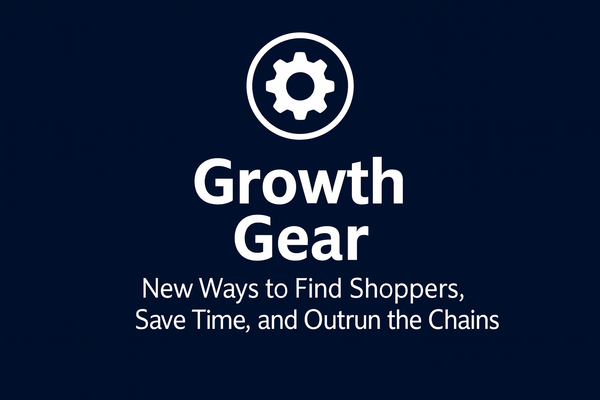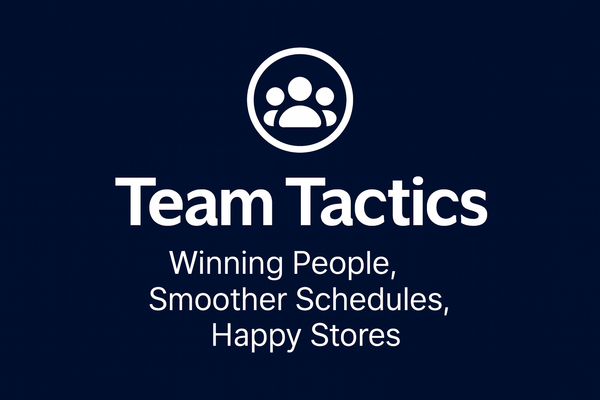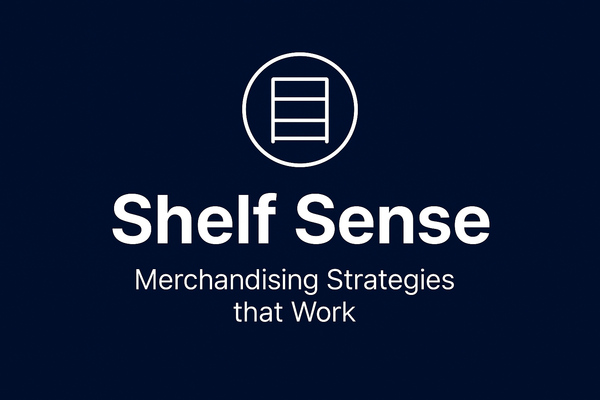First Seconds Count: Making Every Entrance a Welcome Mat
When Evelyn Nakamura transferred to a different Survival Stop location, she couldn't believe the difference that hit her the moment she walked through the door. Her previous store felt cramped and chaotic, but this new location was instantly welcoming.

When Evelyn Nakamura transferred to a different Survival Stop location, she couldn't believe the difference that hit her the moment she walked through the door. Her previous store felt cramped and chaotic—newspapers scattered everywhere, promotional signs blocking the view, and that weird smell nobody could quite identify. But this new location? Clean, bright, and somehow instantly welcoming.
"The crazy thing was, both stores sold basically the same stuff," Evelyn recalls. "But this one just felt better from the second you stepped inside. Customers lingered longer, bought more, and seemed genuinely happy to be there. That's when I realized how much those first few seconds really matter."
The entrance experience can make or break customer relationships before any actual shopping happens. Research shows customers form lasting impressions within seven seconds of entering a store, and those initial feelings heavily influence their purchasing decisions and likelihood to return.
Brennan O'Malley, who worked at both high-performing and struggling locations, puts it simply: "You never get a second chance to make a first impression. Customers decide if they want to shop here or just grab what they need and bolt based on what they see and feel the moment they walk in."
The Psychology of Arrivals
Understanding why first impressions matter so much helps convenience store employees create entrance experiences that actually drive sales and customer loyalty.
Cognitive bias kicks in immediately when people enter new spaces. Customers unconsciously categorize stores as "clean/dirty," "organized/chaotic," and "welcoming/hostile" within seconds, and these snap judgments influence every subsequent interaction.
Stress levels spike for customers entering unfamiliar or poorly organized spaces. When people feel confused or overwhelmed at the entrance, they tend to make quick purchases and leave rather than browsing or considering additional items.
Shopping behavior changes based on initial comfort levels. Customers who feel welcome and oriented are 67% more likely to explore beyond their intended purchases and 43% more likely to return within a week.
Siobhan MacLeod learned this during her store's entrance renovation: "We cleaned up the entry area, organized the promotional displays, and added better lighting. Same products, same prices, but customer dwell time increased by eight minutes on average. People started actually browsing instead of rushing through transactions."
Cleanliness: The Non-Negotiable Foundation
Nothing kills a first impression faster than a dirty entrance. Customers immediately assume that if the front of the store looks bad, the rest—including food safety—is probably worse.
Floor maintenance requires constant attention because entrance floors show dirt, spills, and wear faster than anywhere else. Regular sweeping, mopping, and spot-cleaning throughout the day keep entrances looking professional.
Glass doors and windows create the literal first view of the store interior. Smudged, dirty glass sends immediate signals about store standards and attention to detail.
Trash management around entrances affects both appearance and smell. Overflowing exterior bins, scattered litter, or lingering odors create negative impressions before customers even enter.
Weather response matters because rain, snow, and mud can quickly make clean entrances look terrible. Having systems for dealing with tracked-in moisture and debris prevents weather from destroying first impressions.
Marcus Washington's cleaning routine illustrates practical approaches: "I check the entrance area every hour during my shift—quick sweep, wipe down glass if needed, empty the exterior trash if it's getting full. Takes three minutes but makes a huge difference in how the store feels to customers."
Visual Organization: Guiding the Eye
The entrance area sets expectations for the entire store experience. Smart visual organization helps customers feel oriented and confident about finding what they need.
Clear sightlines into the store let customers see key sections without obstruction. When promotional displays or equipment block views of the interior, customers feel confused and restricted.
Logical flow patterns guide customers naturally toward high-priority areas or popular products. The entrance layout should suggest where to go rather than leaving people standing there wondering what to do next.
Promotional balance showcases deals without creating clutter or confusion. Too many promotional signs overwhelm customers, while too few miss opportunities to highlight value.
Anya Volkov's experience with entrance redesign shows the impact: "We moved a big promotional display that was blocking the view of our coffee station. Coffee sales increased 22% just because people could see it from the entrance and knew where to go for their morning fix."
The Greeting Game: Human Connection
While physical appearance matters enormously, the human element of entrance experiences often determines whether customers feel truly welcome or just tolerated.
Eye contact acknowledgment doesn't require elaborate greetings, but recognizing customers as they enter makes them feel seen and valued rather than invisible.
Genuine warmth comes through in tone and body language more than specific words. A sincere "good morning" beats a scripted corporate greeting every time.
Situational awareness helps employees gauge appropriate interaction levels. Busy customers might prefer quick acknowledgment, while others appreciate brief conversation.
Problem prevention through proactive assistance helps customers who look confused or lost get oriented quickly rather than wandering around frustrated.
Joaquín Herrera's greeting approach demonstrates effective human connection: "I don't use the same greeting for everyone. Business people get a quick 'good morning' and space to shop. Elderly customers might appreciate a comment about the weather. Families with kids often need directions to restrooms or snacks. Reading the situation makes all the difference."
Lighting and Atmosphere: Setting the Mood
Proper lighting and atmospheric elements create emotional responses that influence shopping behavior and overall customer satisfaction.
Brightness levels affect energy and mood significantly. Dim entrance areas feel unwelcoming and potentially unsafe, while harsh fluorescent lighting feels institutional and unpleasant.
Color temperature influences customer perception of cleanliness and freshness. Warmer lighting feels more welcoming, while cooler lighting emphasizes cleanliness and professionalism.
Music and sound create subliminal atmosphere that affects shopping pace and mood. Background music should enhance rather than overwhelm the shopping experience.
Scent management addresses both positive and negative odors that can immediately impact customer comfort and perceptions of store quality.
Rajesh Sharma's atmospheric improvements yielded surprising results: "We adjusted the lighting near the entrance to be brighter and warmer, and customer complaints about the store feeling 'dingy' disappeared completely. Same space, better lighting, totally different customer response."
Strategic Product Placement: The Entrance Advantage
The entrance area represents prime real estate for products that benefit from high visibility and impulse appeal.
Seasonal relevance showcases products that match current weather, holidays, or local events. Entrance displays should reflect what customers are thinking about right now.
High-margin impulse items benefit from entrance placement because customers are most alert and open to suggestions when they first enter.
New product introduction works well near entrances where maximum customer exposure helps build awareness and trial.
Promotional focus draws attention to special deals or limited-time offers that might influence overall shopping decisions.
Fatima Ouali's strategic placement success illustrates the potential: "During summer, we put sunscreen and cold drinks right inside the entrance. Sales of both items doubled because customers saw them immediately when the hot weather reminded them they needed protection and refreshment."
Managing Traffic Flow: The Invisible Current
Understanding and directing customer movement patterns prevents bottlenecks and creates smoother shopping experiences that encourage longer visits.
Entry bottlenecks occur when displays, equipment, or layout features block natural movement into the store. Eliminating these chokepoints improves customer comfort and safety.
Direction signals through placement and visual cues guide customers toward intended areas without requiring signs or verbal directions.
Exit coordination ensures departing customers don't collide with entering ones during busy periods. Simple layout adjustments can prevent awkward traffic jams.
Queue management near registers should be visible from the entrance so customers can gauge wait times and make informed decisions about timing.
Chen Wei-Lin's traffic flow observations led to practical improvements: "We noticed customers were bumping into each other near the entrance during morning rush. Moving a small display three feet over eliminated the bottleneck and made everyone's experience smoother."
Technology and Convenience: Modern Expectations
Today's customers expect certain technological conveniences that can enhance or detract from entrance experiences.
Door functionality seems basic, but malfunctions immediately frustrate customers and create negative impressions. Automatic doors should open promptly and smoothly.
Payment accessibility visible from the entrance helps customers plan their shopping and payment method. Clear sight of payment options reduces checkout anxiety.
WiFi availability matters to customers who want to check prices, look up product information, or stay connected while shopping.
Mobile integration with apps, loyalty programs, or digital coupons should be easily accessible and clearly promoted without being pushy.
Weather Adaptability: Rolling with the Punches
Weather significantly impacts entrance experiences, and successful stores adapt their approach based on seasonal and daily conditions.
Rain preparation includes mats, umbrella stands, and quick cleanup protocols for tracked-in water. Customers appreciate stores that help them deal with weather challenges.
Heat management during summer might involve strategic fan placement, cold drink positioning, or air conditioning optimization near entrances.
Winter considerations include ice removal, heating near doors, and placement of seasonal items that customers suddenly need.
Wind protection prevents doors from slamming, papers from flying around, or displays from toppling during gusty conditions.
The Ripple Effect: How Entrances Impact Everything
Great entrance experiences create positive momentum that affects customer behavior throughout their entire visit.
Extended shopping time occurs when customers feel comfortable and welcome from the start. Relaxed customers browse more sections and consider additional purchases.
Increased basket size results from positive first impressions that put customers in buying moods rather than purely functional mindsets.
Return likelihood correlates strongly with entrance experiences because first impressions heavily influence whether customers want to come back.
Word-of-mouth recommendations often mention store atmosphere and "feel," which starts with entrance experiences.
Isabella Rossi's holistic approach demonstrates comprehensive impact: "Once we focused on making great first impressions, everything improved—customer satisfaction scores, average transaction size, repeat visits. The entrance is like the foundation of the whole customer experience."
Small Changes, Big Results
Improving entrance experiences doesn't require major renovations or significant investments. Often, small adjustments create disproportionate improvements in customer response.
Daily maintenance routines that include entrance-specific tasks keep spaces looking fresh and welcoming consistently.
Weekly deep cleaning of entrance areas maintains professional appearance and prevents gradual deterioration of first impressions.
Monthly evaluation of entrance effectiveness through customer observation and feedback helps identify improvement opportunities.
Seasonal updates keep entrance areas relevant and fresh without requiring complete overhauls.
The Employee Opportunity
For convenience store employees, understanding and contributing to great entrance experiences provides career development opportunities and job satisfaction benefits.
Customer service skills developed through entrance interactions transfer to every other aspect of retail work and customer relationship management.
Business understanding of how physical environment affects sales behavior provides valuable insights for advancement opportunities.
Problem-solving abilities exercised through entrance optimization challenges develop critical thinking skills applicable across many situations.
The Bottom Line on First Impressions
Every convenience store employee plays a role in creating entrance experiences that either welcome customers or drive them away. From maintaining cleanliness to offering genuine greetings to optimizing product placement, frontline staff control many factors that determine first impression success.
"I never realized how much power I had to influence customer experience just by paying attention to the entrance area," reflects Thabo Mthembu, whose proactive approach earned recognition from management. "Simple things like keeping it clean, greeting people warmly, and making sure displays look good can literally make or break someone's entire shopping experience."
For convenience store employees, mastering entrance strategies provides immediate job satisfaction through positive customer interactions while building valuable skills for career advancement. When employees understand that they're creating the foundation for every customer relationship, routine tasks become opportunities to make meaningful differences in both business success and personal professional development.
The entrance isn't just where customers walk in—it's where relationships begin, expectations form and shopping experiences get shaped. Employees who master this critical first moment often discover they've unlocked the key to both customer satisfaction and their own career growth.





